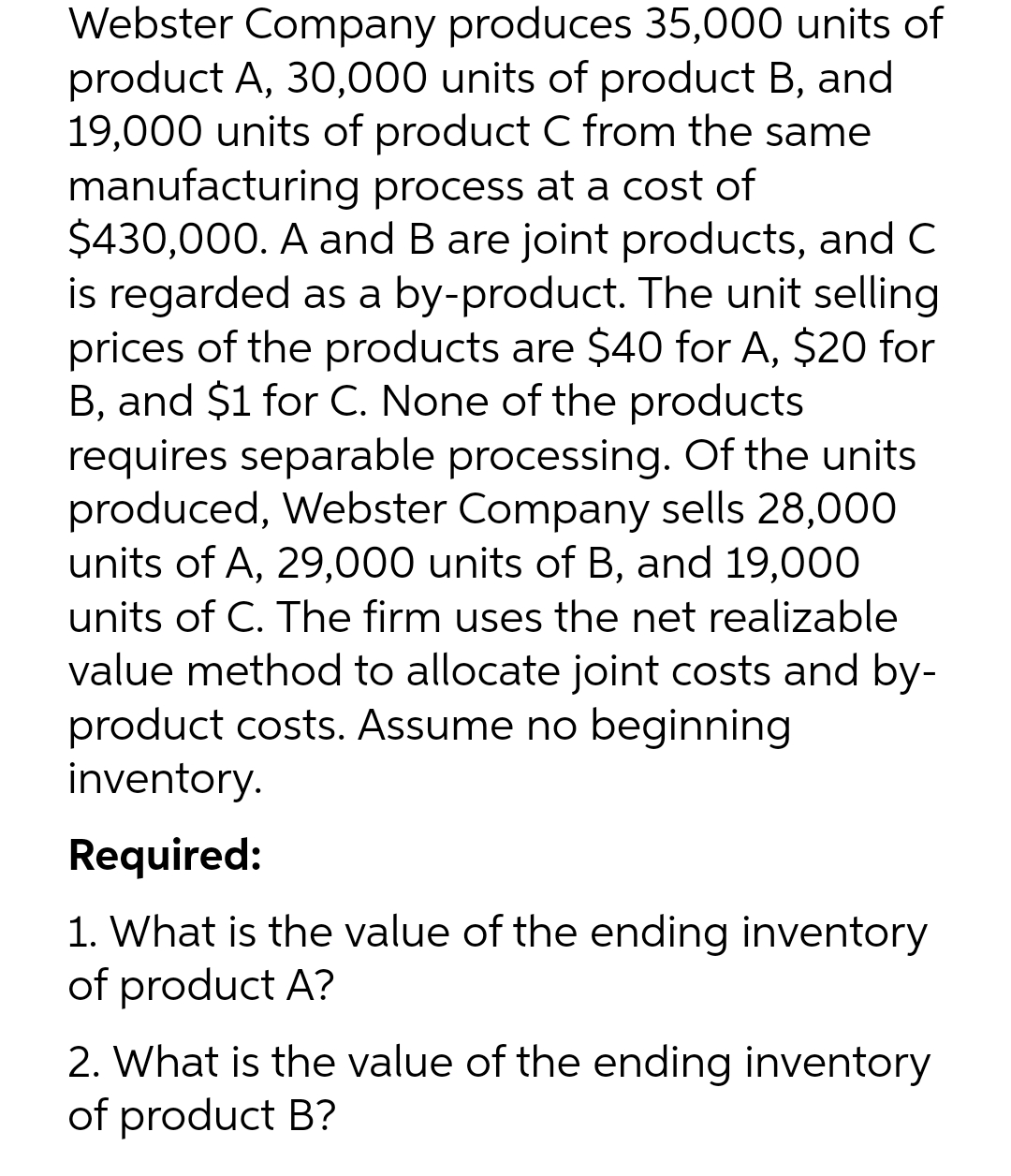Webster Company produces 35,000 units of product A, 30,000 units of product B, and 19,000 units of product C from the same manufacturing process at a cost of $430,000. A and B are joint products, and C is regarded as a by-product. The unit selling prices of the products are $40 for A, $20 for B, and $1 for C. None of the products requires separable processing. Of the units produced, Webster Company sells 28,000 units of A, 29,000 units of B, and 19,000 units of C. The firm uses the net realizable value method to allocate joint costs and by- product costs. Assume no beginning inventory. Required: 1. What is the value of the ending inventory of product A? 2. What is the value of the ending inventory of product B?
Webster Company produces 35,000 units of product A, 30,000 units of product B, and 19,000 units of product C from the same manufacturing process at a cost of $430,000. A and B are joint products, and C is regarded as a by-product. The unit selling prices of the products are $40 for A, $20 for B, and $1 for C. None of the products requires separable processing. Of the units produced, Webster Company sells 28,000 units of A, 29,000 units of B, and 19,000 units of C. The firm uses the net realizable value method to allocate joint costs and by- product costs. Assume no beginning inventory. Required: 1. What is the value of the ending inventory of product A? 2. What is the value of the ending inventory of product B?
Principles of Cost Accounting
17th Edition
ISBN:9781305087408
Author:Edward J. Vanderbeck, Maria R. Mitchell
Publisher:Edward J. Vanderbeck, Maria R. Mitchell
Chapter6: Process Cost Accounting—additional Procedures; Accounting For Joint Products And By-products
Section: Chapter Questions
Problem 14E: LeMoyne Manufacturing Inc.’s joint cost of producing 2,000 units of Product X, 1,000 units of...
Related questions
Question
5

Transcribed Image Text:Webster Company produces 35,000 units of
product A, 30,000 units of product B, and
19,000 units of product C from the same
manufacturing process at a cost of
$430,000. A and B are joint products, and C
is regarded as a by-product. The unit selling
prices of the products are $40 for A, $20 for
B, and $1 for C. None of the products
requires separable processing. Of the units
produced, Webster Company sells 28,000
units of A, 29,000 units of B, and 19,000
units of C. The firm uses the net realizable
value method to allocate joint costs and by-
product costs. Assume no beginning
inventory.
Required:
1. What is the value of the ending inventory
of product A?
2. What is the value of the ending inventory
of product B?
Expert Solution
This question has been solved!
Explore an expertly crafted, step-by-step solution for a thorough understanding of key concepts.
Step by step
Solved in 2 steps

Knowledge Booster
Learn more about
Need a deep-dive on the concept behind this application? Look no further. Learn more about this topic, accounting and related others by exploring similar questions and additional content below.Recommended textbooks for you

Principles of Cost Accounting
Accounting
ISBN:
9781305087408
Author:
Edward J. Vanderbeck, Maria R. Mitchell
Publisher:
Cengage Learning

Principles of Accounting Volume 2
Accounting
ISBN:
9781947172609
Author:
OpenStax
Publisher:
OpenStax College

Financial And Managerial Accounting
Accounting
ISBN:
9781337902663
Author:
WARREN, Carl S.
Publisher:
Cengage Learning,

Principles of Cost Accounting
Accounting
ISBN:
9781305087408
Author:
Edward J. Vanderbeck, Maria R. Mitchell
Publisher:
Cengage Learning

Principles of Accounting Volume 2
Accounting
ISBN:
9781947172609
Author:
OpenStax
Publisher:
OpenStax College

Financial And Managerial Accounting
Accounting
ISBN:
9781337902663
Author:
WARREN, Carl S.
Publisher:
Cengage Learning,

Managerial Accounting
Accounting
ISBN:
9781337912020
Author:
Carl Warren, Ph.d. Cma William B. Tayler
Publisher:
South-Western College Pub

Cornerstones of Cost Management (Cornerstones Ser…
Accounting
ISBN:
9781305970663
Author:
Don R. Hansen, Maryanne M. Mowen
Publisher:
Cengage Learning